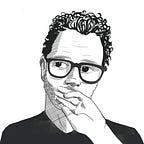Hayao Miyazaki’s Cure For Writer’s Block
Do you want to write a novel, a comic or a screenplay and feel like you just can get started? Maybe it feels like you have loads of ideas but you can’t pick one?
Three years ago, the great Japanese animator Hayao Miyazaki took my hand and showed me a way out of my own writer’s block. Since then, I’ve written 30 short stories, published two short story collections and I’m deep into the drawing of my debut graphic novel.
It’s all thanks to this low-fi and intimate Japanese documentary: 10 Years with Miyazaki, produced by national broadcaster NHK.
It’s available — for free! — on their website and follows him as he directs Ponyo On The Cliff By The Sea (2008) and The Wind Rises (2013), one of my favourites.
Studio Ghibli insisted that only one person shoot the documentary and so the film has the air of home movie footage as the camera operator dutifully follows an often grumpy Miyazaki, shoving the camera in his face as he sketches storyboards, an unlit cigarette drooping from his upper lip.
“Why are you filming?” Miyazaki occasionally snaps, “can’t you tell when someone wants to be left alone?”
“I’m sorry,” the filmmaker responds, and then continues filming.
There’s a whole bunch of fascinating takeaways, from Miyazaki’s morning routine (which Mason Curry writes about in detail here), to his obsession with showing rather than telling; from his heartbreaking relationship with his son Goru, captured in painful detail; and what seems to be a toxic work environment at Studio Ghibli, centred around the mercurial emotions of a ‘genius’.
But one thing about Miyazaki’s process has stuck with me for a couple of weeks now and even changed how I create. I want to share it with you.
You don’t have to start at the beginning
Most films begin as a screenplay and most screenplays begin with “SCENE 1: EXT. STREET” — that’s where the screenwriter begins.
Miyazaki doesn’t write screenplays. Instead he works entirely in images, which someone else turns into words.
I noticed that Miyazaki draws very loose and kind of feels his way through a drawing. He’s improvising on the page.
And he starts by capturing whatever moment or image he has in his head right then.
Then he paints it in watercolour. This painting captures three separate possible shots, collaged on the same page.
Here’s why this has been somewhat revelatory for me: stories don’t come to me fully formed, and they certainly don’t come to me in a convenient order. They appear as single scenes, moments, images, sometimes just feelings.
I have moments like these for a dozen different stories floating around my head, and none of them are the opening scene of whatever story they’re supposed to be.
This has stopped me in my tracks, because I always kind of thought you start a story at the beginning. Why start if you don’t have a beginning?
As I watched Hayao Miyazaki painting Ponyo, I realised I don’t need to wait for the opening scene to arrive to start telling a story. I can start by exploring the images that are already in my head and just see where they lead me.
In the 10 days since I watched the documentary, I filled page upon page of my sketchbook with loose comics and collages, trying to capture the actions and emotions of scenes I do have. Some of them had been floating in my brain for ten years, and were finally getting made manifest.
Getting those single scenes on paper was like clearing out my creative attic. It freed up space for new ideas. Slowly a momentum built: single scenes became two scenes, which became a short story, one short story became two and before long I had a dozen of them. And so on.
And as I drew, I caught myself thinking “I’m doing it! I’m drawing stories!” And more often than you’d think, I would put my pencil down and feel proud of what I made.
So here’s the takeaway: if you’re feeling stuck, forget about writing a whole book or a screenplay. Just pick the one scene, the one moment that feels most vivid in your head and get that down in paper.
To begin, sometimes you just have to begin — and it doesn’t have to be at the beginning.
